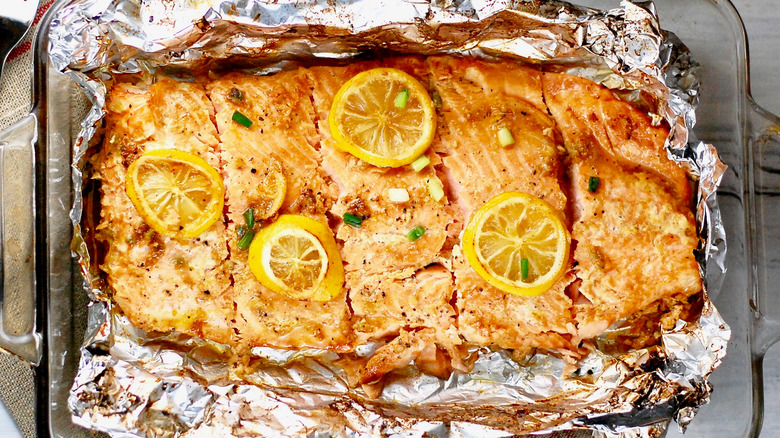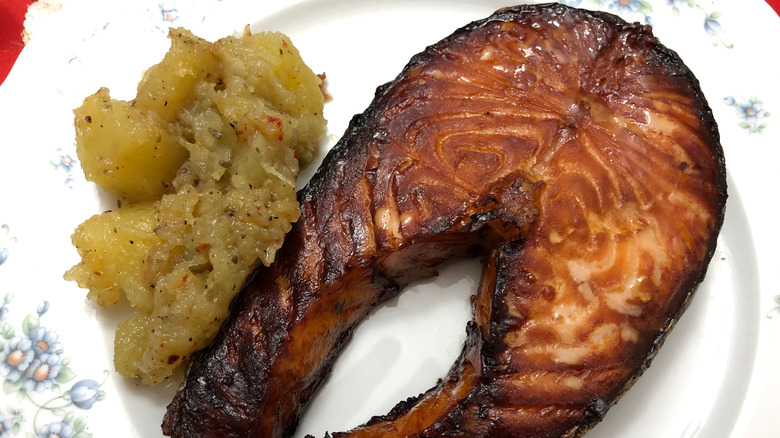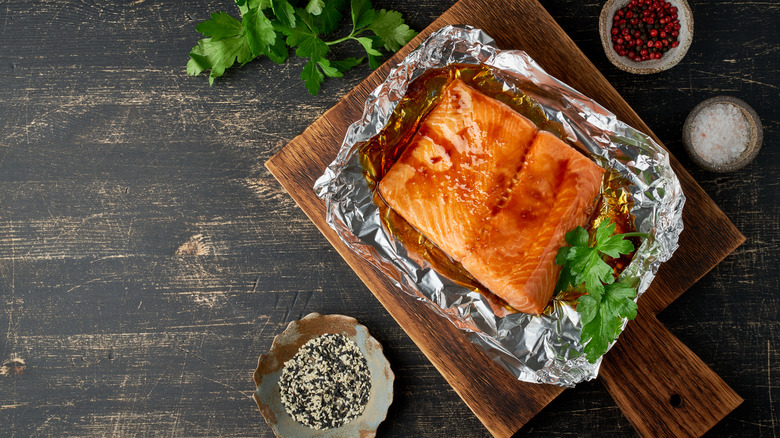Why You Should Be Baking Salmon In Foil
Salmon is well known as a fattier cut of fish. It can withstand cooking methods that would turn delicate white fish filets to jerky, but that doesn't mean that it's invincible. Just because salmon feels like it's closer to a steak than seafood doesn't mean it can endure the same high-heat preparations without drying out. That's why it's best to use barriers to help seal in moisture when baking salmon, and there might be none more effective than aluminum foil.
Barriers are cooking elements that help mitigate the dry heat of an oven. This includes salmon skin (which you can leave on to get nice and crispy), liquids like olive oil and butter that disperse heat, and of course aluminum foil that traps in steam. By combining all three of these, you'll ensure that your finished filet will have all of salmon's rich flavors every time.
Why salmon tends to dry out
Grilled meats tend to dry out because they are too lean and don't have enough fat to stay moist while cooking. While this is still the case with many types of fish, they also tend to have shorter muscle fibers than beef, poultry, or pork. This means that their fat and collagen leave the muscle fibers much more easily.
This is the primary reason that folks tend to dry out fish when they cook it. Salmon typically has above-average fat content for a fish, which means it's a little hardier than other cuts of fish, but it can still get dried out. Fat content also differs depending on what kind of salmon you purchase from the store — wild salmon tends to have less fat and is more prone to drying out than its farmed counterpart.
There are plenty of great ways to enjoy salmon, but the best ones give you a tender, juicy cut that's still full of flavor because it hasn't been overcooked. Perfectly cooked salmon should flake easily with a fork without falling apart completely and still be semi-translucent inside. These are the go-to signs that show your salmon still has plenty of fat inside its muscle fibers that will translate to flavor. And the best way to achieve this is by using a gentle heat thanks to an aluminum foil barrier.
How to properly bake salmon in foil
Baking salmon in foil is not only one of the best methods but also one of the easiest. Start by preheating your oven to 350 degrees F and lining your pan with aluminum foil. At this stage you can either leave enough foil attached that it will be able to fold and seal over your salmon or cut off a second piece that you put overtop later.
Coat the foil with nonstick spray or cooking oil and place the salmon on top — skin-side down. Next, add your desired seasoning. A simple mix of citrus and melted butter is enough to add tons of flavor and depth to a good cut of salmon. You could also add a mirin glaze or pesto coating. Just know that adding more liquid fat like butter and oil will improve the chances that your fish keeps its flavor. Fold or place the additional aluminum foil over your salmon, and then transport it to the oven. Give it about 20 minutes to bake before carefully releasing some of the trapped steam and checking to see if your salmon is fork-tender.
If you want to finish your salmon off with a nice browned crust, you can give it about five minutes uncovered under the broiler, but otherwise you're ready to serve.


